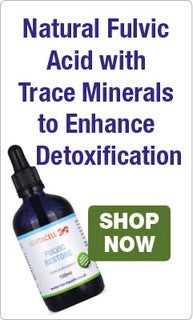Fulvic acid is the unsung hero of health – a mighty antioxidant, a powerful polyelectrolyte and a complex organic phenol that facilitates the healthy absorption of all nutrients in food. Look up ‘fulvic acid’ in the news, though, and you’ll mostly see tumbleweed.
Unlike vitamins, probiotics, proteins and antioxidants, fulvic acid is largely ignored, its many benefits unheralded by the mainstream media. Which is puzzling for a number of reasons, not least because fulvic acid helps our bodies use and absorb the aforementioned nutrients better. In a way, it’s like praising the performance of a marionette without crediting the puppeteer skilfully controlling the strings.
What is Fulvic Acid?
Fulvic acid is one of two types of humic acid – soluble organic compounds that exist in the earth’s soil, in rock sediments and in water. Known as a delivery system that transports nutrients to plants, fulvic acid is sometimes referred to as ‘the miracle molecule’.
Amazingly, a single fulvic acid molecule has the ability to transport dozens of minerals into the cells of a plant. Not only that, but the biologically-rich compounds help the plant retain and properly utilise these nutrients.
Additional benefits include improved seed germination, greater fibrous root growth and optimum plant respiration. Unless you’re a gardener, you might be less interested in fulvic acid’s capacity to help plants than in how it might be of use to humans. Ah, but we’re coming to that!
Fulvic Acid Benefits
You see, fulvic acid helps us in much the same way it helps plants. As well as acting as an essential vehicle to increase the availability of nutrients in the food we ingest, it nourishes the digestive tract, allowing for the formation of healthy bacteria.
Studies have even demonstrated that fulvic acid has significant antibacterial effects. In one, a mouthwash containing fulvic acid was shown to limit the proliferation of growth-causing bacteria, which prevents gingivitis and other oral diseases.
Fulvic acid’s therapeutic potential is no secret, but in the western world, we have been somewhat slow on the uptake: for a long time China led the way, and in the late ‘80s and early ‘90s some ground breaking discoveries were made. Fulvic acid was shown to be useful in treating a range of health complaints, from ulcerous cornea infections and chronic ulcerous colon infections to acute upper gastroenterological bleeding and haemorrhoids.
Hundreds of research papers have now appeared nationally in China, with fulvic-related medicines being used to reduce inflammation, improve circulation, regulate the immune and hormone systems and heal digestive tract disorders.
In recent years the sphere of interest has widened, and fulvic acid has now attained a degree of prominence in the realm of natural health. Anecdotal evidence suggests it can:
- Improve gut health
- Protect cognitive health
- Counteract free radicals
- Protect skin and even treat conditions such as eczema
A cursory investigation of fulvic acid’s positive effects uncovers a veritable treasure trove of data, so it’s certainly worth digging deeper.
But Don’t We Get Enough Fulvic Acid From Vegetables?
Since fulvic acid exists in the soil, surely we already consume plenty in the plants we eat? Well, sadly not. Although nature intended this to be the case, much of our soil is suffering from poor agricultural practices, pesticides, chemical fertilisers, erosion and mineral depletion. Market forces mean food quality is sacrificed for food quantity, with high-yield trumping nutrient density. Thus, despite fulvic acid being essential for cell metabolism, for generations it has been available to us in diminished quantities. And if you’re already neglecting to eat leafy green vegetables, so much the worse.
Don’t Settle for a Second-rate Supplement
Given the compromised nature of our soil, we are increasingly turning to food-grade fulvic acid supplements to boost our intake of these important organic compounds. Fulvic Restore is one such product, notable for its chemical-free, pure-water extraction process. That extraction occurs in Alberta, Canada, from a fertile deposit of ancient, long since decayed plant matter, and the resultant liquid is packed with minerals, electrolytes, trace elements, trace minerals and over 30 organic acids.
If you want to improve your digestion, gently detoxify, boost energy levels or increase nutrient assimilation, Fulvic Restore is a fine option.
Many fulvic acid supplements are available, and several are known to become cloudy and form into an unappetising gunk in the bottom of the glass. This is a dead giveaway of low fulvic acid content, and these products should be steadfastly avoided.
Thankfully, Fulvic Restore’s fulvic content levels are as high as 5%, in addition to the aforementioned swathe of minerals and elements. The recommended usage is 8 drops taken twice daily in a small amount of water – ideally filtered, bottled or alkaline.
As ever, there’s no substitute for a well-balanced diet and proper exercise routine. Having said that, a nutritious fulvic acid supplement can confer many benefits on the body. As the literature on the subject continues to grow, there’s never been a better time to take advantage of this under-the-radar natural supplement.




























Leave a comment